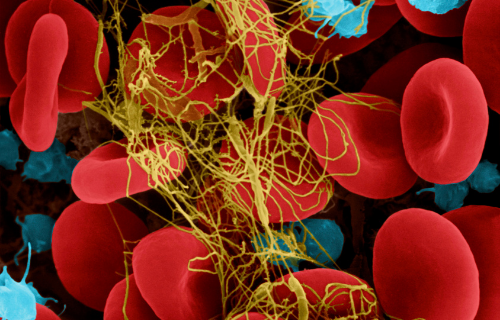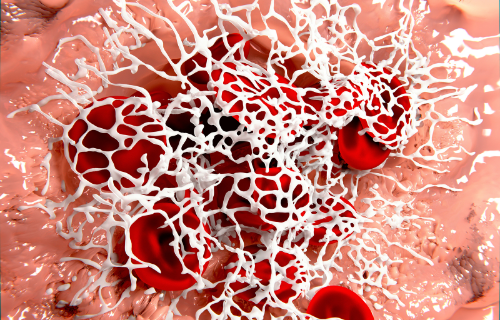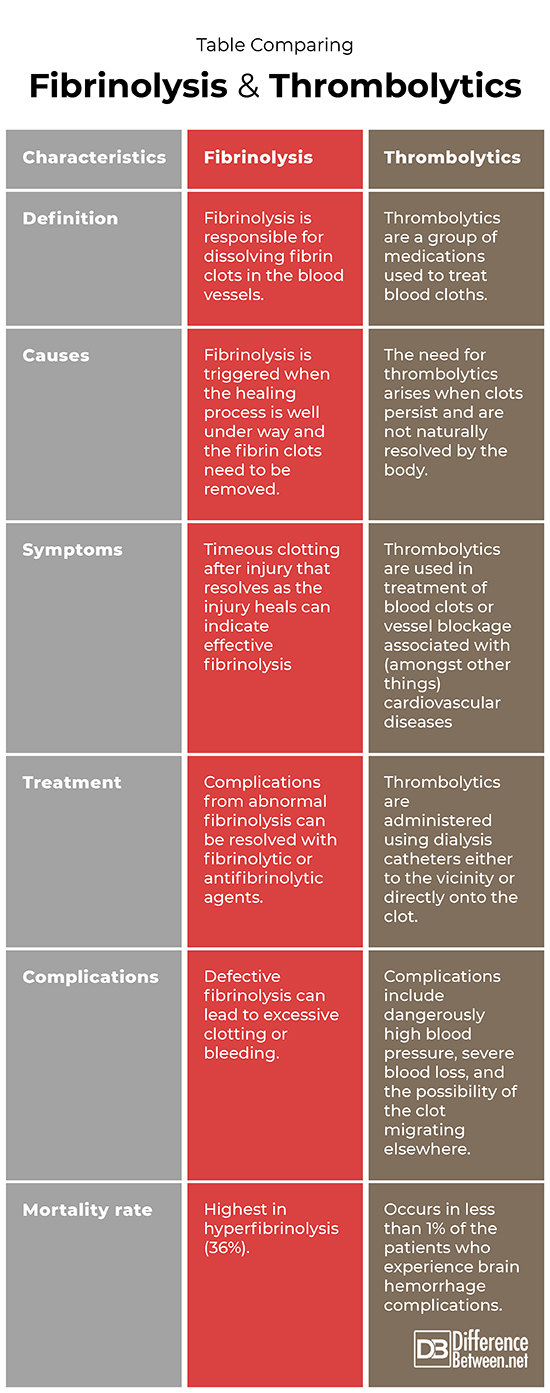Difference Between Fibrinolysis and Thrombolytics
Fibrinolysis is biochemical process that removes fibrin clots during the injury healing process while thrombolytics are a group of medicines used to treat blood clots in disorders such as cardiovascular diseases.

What is fibrinolysis?
Definition:
Fibrinolysis (part of hemostasis process) occurs in the blood and is responsible for dissolving fibrin clots in the blood vessels.
Causes and risk factors:
Blood clots are critical to healing injuries that involve blood vessels and bleeding. Fibrinolysis is responsible for the elimination of fibrin clots during the healing process. However, this process needs to be tightly regulated to prevent premature dissolution of fibrin clots or insufficient clot elimination.
Diagnosis:
Fibrinolysis, which eliminates clots from the blood, occurs in two parts; plasminogen activators convert plasminogen to plasmin and then plasmin breaks down fibrin clots. Sufficient clotting followed by the disappearance of clots and the return of normal blood flow after injury healing is a good indication that the fibrinolysis process fulfilled its purpose.
Symptoms:
In abnormal fibrinolysis, the consequences can include excessive bleeding or clotting. Otherwise, temporary clotting upon injury that resolves as the injury heals is suggestive of normal fibrinolysis.
Complications:
If the fibrinolysis process is faulty, it can be hyperactive or underactive thus leading to excessive bleeding or clotting, respectively. Both situations can be serious and fatal.
Treatment:
Fibrinolysis-related excessive clotting and bleeding are treated with thrombolytic or fibrinolytic agents and antifibrinolytic agents, respectively.

What is thrombolytics?
Definition:
Thrombolytics are a group of medications used to treat strokes and heart attacks, approved for use in case of emergency. They treat strokes and heart attacks by eliminating blood clots thus improving blood flow and dissolving dangerous blood clots.
Causes and risk factors:
Thrombosis may occur because of excessive clotting or clotting in the absence of bleeding. If the body cannot resolve this, a thrombolytic agent may be administered to resolve the block.
Thrombolytics use is contraindicated in patients at higher risk of bleeding such as those on blood thinners.
Diagnosis:
Clots located in arteries to the lungs, heart and brain, are earmarked for emergency use of thrombolytics.
Symptoms:
Clotting disorders that can be treated using thrombolytics include cardiovascular diseases such as myocardial infarction and strokes.
Complications:
Complications include dangerously high blood pressure, severe blood loss, severe kidney disease and the possibility of the clot migrating elsewhere.
In 12% of the patients the clot or blockage may recur.
Approximately 25% of people experience some nose and gums bleeding after receiving thrombolytics.
On rare occasions (1%) of the patients who receive thrombolytics can bleed into the brain.
Treatment:
Thrombolytic therapy intervenes by delivering the plasminogen activator into the blood circulation.
Thrombolytics are administered by using a dialysis catheter to get as close as possible to the clot before delivering the medication either directly or in the vicinity of the clot.
Radiological imaging is used to aid in this process.
Difference between Fibrinolysis and Thrombolytics
1. Definition
Fibrinolysis is a biochemical process that is responsible for resolving fibrin clots in the blood vessels. Thrombolytics are a group of medications used to dissolve clots associated with serious conditions such as strokes and heart attacks.
2. Causes
Fibrinolysis naturally eliminate fibrin clots. Thrombolytics administration is done to resolve clots and blockages that the body does not resolve clots on its own.
3. Symptoms
When fibrinolysis proceeds as expected wounds heal normally with fibrin clots resolving as the healing process advances. Persistent clots that do not resolve indicate a possible need for thrombolytics.
4. Treatment
Fibrinolysis is a tightly controlled biochemical process that resolves fibrin clots that appear as part of the natural healing process. Thrombolytic therapy intervenes by delivering the plasminogen activator into blood circulation to treat blood clots.
5. Complications
Complications from faulty fibrinolysis include excessive bleeding or clotting while complications from thrombolytic therapy includes recurrent clots or blockages, kidney diseases and relocation of the clot.
6. Mortality rate
Hyperfibrinolysis is the most fatal complication (36% mortality compared to 22% in complete shutdown of fibrinolysis).
Of the patients that experience brain hemorrhage complication of thrombolytic therapy death only occurs in less than 1%.
Table comparing Fibrinolysis and Thrombolytics

Summary of Fibrinolysis and Thrombolytics
Fibrinolysis is a biochemical process that dissolved fibrin clots during injury healing. Thrombolytics are a group of medications administered to resolve potentially dangerous clots that are not resolved by the body.
Due to their function in dissolving clots, complications from fibrinolysis and thrombolytics can include unusual excessive bleeding.
FAQ:
Is fibrinolysis and fibrinolytic system same?
Fibrinolysis is part of the fibrinolytic system, but this system does more than removing fibrin clots (fibrinolysis). Amongst other things, it is also involved in the elimination of misfolded proteins.
What is the difference between anticoagulants and Fibrinolytics?
Fibrinolytics aids the elimination of fibrin clots while coagulants a repress the synthesis of clots.
What is the difference between thrombolytics and anticoagulants?
Thrombolytics are used to dissolve existing clots while anticoagulants prevent clot formation.
Is tPA a thrombolytic or fibrinolytic?
tPA is both a fibrinolytic and a thrombolytic agent.
- Difference Between Pericarditis and Costochondritis - April 8, 2022
- Difference Between Fibrinolysis and Thrombolytics - March 29, 2022
- Difference Between Necrosis and Infarction - March 18, 2022
Search DifferenceBetween.net :
Leave a Response
References :
[0]Ansorge, Rick. “Thrombolysis: Definition, Types, Uses, Effects, and More.” WebMD, WebMD, 7 Mar. 2021, https://www.webmd.com/stroke/thrombolysis-definition-and-facts. Accessed: 10 February 2022.
[1]Baig, M.U. “Thrombolytic Therapy.” StatPearls [Internet]., U.S. National Library of Medicine, 17 June 2021, https://www.ncbi.nlm.nih.gov/books/NBK557411/. Accessed: 10 February 2022.
[2]Brass, Lawrence M., et al. "Intracranial hemorrhage associated with thrombolytic therapy for elderly patients with acute myocardial infarction: results from the Cooperative Cardiovascular Project." Stroke, vol. 31 no. 8, 2000, pp. 1802-1811.
[3]Califf, R.M., et al. “Clinical Risks of Thrombolytic Therapy.” The American Journal of Cardiology, vol. 69, no. 2, 1992, pp. 12–20, doi:10.1016/0002-9149(92)91168-4.
[4]Collen, D., and H. R. Lijnen. “Basic and Clinical Aspects of Fibrinolysis and Thrombolysis.” Blood, vol. 78, no. 12, 1991, pp. 3114–24, doi:10.1182/blood.v78.12.3114.bloodjournal78123114.
[5]Draxler, Dominik F., and Robert L. Medcalf. “The Fibrinolytic System—More than Fibrinolysis?” Transfusion Medicine Reviews, vol. 29, no. 2, Elsevier Inc., 2015, pp. 102–09, doi:10.1016/j.tmrv.2014.09.006.
[6]HOSP Enterprise. “Thrombolytics - Indications, Contraindications, Side Effects, Interactions.” HOSP Enterprise, 10 Apr. 2019, http://hospenterprise.com/medications/thrombolytics/. Accessed: 8 February 2022.
[7]Kolev, K., and C. Longstaff. “Bleeding Related to Disturbed Fibrinolysis.” British Journal of Haematology, vol. 175, no. 1, 2016, pp. 12–23, doi:10.1111/bjh.14255.
[8]Moore, H.B., et al. "Acute fibrinolysis shutdown after injury occurs frequently and increases mortality: a multicenter evaluation of 2,540 severely injured patients. "Journal of the American College of Surgeons vol. 222, no. 4, 2016, pp. 347-355.
[9]Samama, M., et al. “Comparison of Thrombolytic, Fibrinolytic, and Fibrinogenolytic Properties of Tissue Plasminogen Activator, Streptokinase, Single‐Chain Urokinase, High Molecular Weight and Low Molecular Weight Urokinase in Human Plasma in Vitro.” Fundamental & Clinical Pharmacology, vol. 2, no. 6, 1988, pp. 509–23, doi:10.1111/j.1472-8206.1988.tb00652.x.
